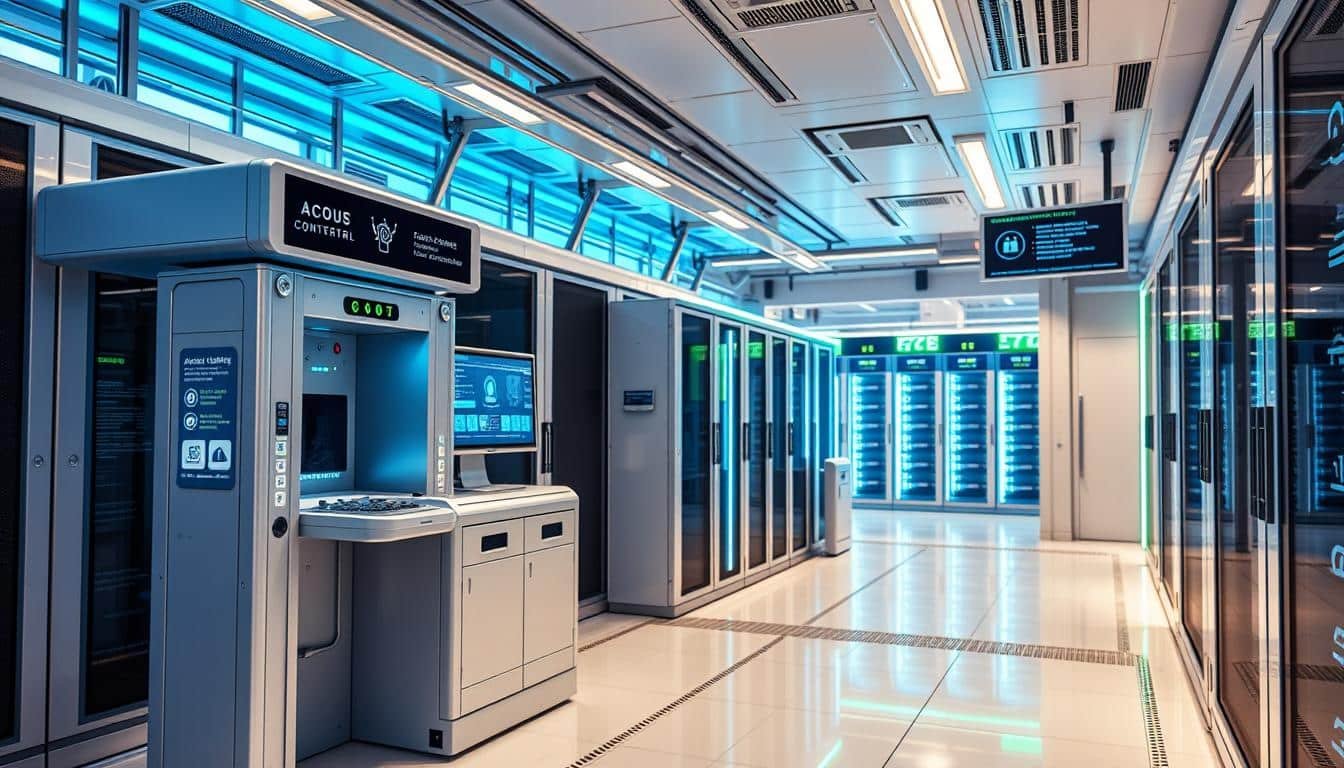In today’s digital world, keeping your data center safe and accessible is key. The Identity, Credentialing, and Access Management (IDCW) system is vital for this. It manages who can access your data and systems, protecting your sensitive information.
Data centers face many security challenges today. They must fight off cyber threats and make sure only the right people can get in. A strong IDCW system is essential for managing this. We’ll look at how IDCW impacts data center security and access, helping you protect your digital assets.
Key Takeaways
- IDCW is a critical component of modern data center security, governing user identities, permissions, and access privileges.
- Effective IDCW systems help mitigate cyber threats and ensure authorized personnel can access the data center securely.
- Implementing robust multi-factor authentication, biometric security, and privileged access management are key strategies for enhancing data center security.
- Compliance with industry-specific regulations and maintaining robust audit trails are essential for data centers to maintain regulatory compliance.
- Proactive risk assessment and continuous monitoring are crucial for data centers to stay ahead of evolving security threats.
Understanding IDCW and Its Role in Modern Data Centers
In today’s fast-changing data center security world, IDCW (Identity, Devices, Credentials, and Workloads) is key. It helps manage access and protect your data. This system keeps your organization safe from cyber threats.
Key Components of IDCW Infrastructure
IDCW has three main parts: identity management, network access controls, and security audits. Identity management checks who can access what. Network access controls watch over data center traffic to keep it safe.
Evolution of Data Center Security Protocols
Data center security has grown a lot. It now uses AI and biometrics instead of just passwords. This makes it harder for hackers to get in.
Current Industry Standards and Best Practices
Keeping your data center safe means following the latest standards. Regular security checks and strong access controls are crucial. This keeps your data safe and your business running smoothly.
| Component | Description | Importance |
|---|---|---|
| Identity Management | Authenticates users, devices, and applications | Ensures only authorized access to data center resources |
| Network Access Controls | Regulates and monitors traffic flow within the data center | Prevents unauthorized access and data breaches |
| Security Audits | Evaluates the effectiveness of security protocols and identifies areas for improvement | Maintains the integrity of the data center and ensures compliance with industry standards |
Knowing about IDCW and keeping up with new standards helps protect your data center. It keeps your business safe from digital threats.
How IDCW Affects Data Center Security and Access Control
Integrated Data Center Workloads (IDCW) are key to better data center physical security, cybersecurity protocols, and network access controls. They blend various security steps to protect vital infrastructure and data from many threats.
IDCW makes physical security in data centers stronger. It uses top-notch access control systems. This means only approved people can get into the facility, cutting down on unauthorized access and data breaches.
Also, IDCW’s link with cybersecurity protocols keeps organizations ahead of digital dangers. It uses advanced threat detection and response. This way, IDCW can spot and stop suspicious actions fast, keeping data and systems safe.
IDCW is also key in boosting network access controls. It sets up strong user checks and permissions. This lets only the right people access sensitive data and apps.
| IDCW Benefits | Description |
|---|---|
| Improved Physical Security | Advanced access control systems to prevent unauthorized entry |
| Enhanced Cybersecurity | Robust threat detection and response mechanisms to mitigate digital threats |
| Strengthened Network Access Control | Effective user authentication and authorization processes to manage access |
IDCW brings together these vital security parts. It helps organizations build a strong, safe data center. This makes data breaches less likely and keeps valuable assets safe.
“IDCW is a game-changer in the world of data center security, offering a holistic approach to safeguarding critical infrastructure and sensitive information.”
Implementation of Multi-Factor Authentication Systems
In today’s world, keeping data centers safe is key. Multi-factor authentication (MFA) is a big part of this. It ensures that only the right people can access the data center, keeping your important data and systems safe from hackers.
Biometric Security Integration
Biometric authentication is a big step forward in MFA. It uses things like fingerprints, faces, and irises to check who you are, making it really hard for bad guys to get in.
Smart Card Technologies
Smart cards are also important for MFA. They can hold and process data, making it easy to check who’s logging in. By using a smart card and a PIN or password, you can make your data center even safer.
Mobile Authentication Solutions
Mobile devices have changed how we do MFA. They use phones to send codes or check biometric data. This makes logging in easier and keeps your data safe.
Using multi-factor authentication with biometrics, smart cards, and mobile tech makes your data center very secure. It keeps your identity and access management (IAM) strong. And it protects your biometric authentication from hackers.
Physical Security Measures and Privileged Access Management
In the world of data centers, keeping things safe is crucial. It’s not just about virtual walls. You need a mix of tech and people to protect your data. This includes things like cameras and locked server rooms.
Access-controlled zones are a big part of keeping data centers safe. By setting up restricted areas, you can stop unauthorized people from getting in. This means only those who should can access important systems and gear. Tools like biometric scanners and smart cards help check who’s allowed in.
Privileged access management is also key. It’s about giving people only the access they need to do their jobs. Regular checks help spot weak spots and keep an eye on who has access. This helps prevent data leaks and unauthorized changes to important systems.
“Physical security is the foundation upon which data center security is built. Without it, all other security measures are vulnerable.”
By using strong data center physical security and privileged access controls, you can make your data center safe. Regular security audits help keep it that way. This protects your organization’s most valuable assets.
Compliance and Regulatory Requirements in IDCW Implementation
When you start using IDCW in your data center, you must understand the rules. These rules vary based on your business type. For example, healthcare needs to follow HIPAA, while finance must comply with PCI DSS. These rules set the standards for keeping your data safe.
Industry-Specific Regulations
Learn about the rules that apply to your field. This knowledge helps shape your IDCW plan. It ensures your data center meets all the required standards. Keep up with any rule changes to avoid legal issues.
Audit Trail Documentation
Keeping detailed records of all access and security events is key. This helps in fixing problems and shows you follow the rules. It’s important for audits and inspections.
Risk Assessment Protocols
Use strong risk assessment methods to find and fix weaknesses. Regularly check your security and update it as needed. This keeps your data safe from new threats and meets compliance standards.
FAQ
How does IDCW affect data center security and access control?
IDCW (Identity, Credentialing, and Access Management) is key to data center security. It boosts physical security and strengthens cybersecurity. It also improves network access, reducing data breach risks and boosting efficiency.
What are the key components of IDCW infrastructure?
IDCW’s core includes identity management, access control systems, and credential issuance. These ensure only authorized people can access sensitive data and systems.
How has the evolution of data center security protocols affected IDCW?
New security protocols have led to advanced, AI-driven IDCW solutions. This includes biometric security, smart cards, and mobile authentication. These aim to improve data center security and access control.
What are the current industry standards and best practices for IDCW implementation?
Today’s IDCW standards focus on regular security audits and following regulations. They also advocate for a multi-layered approach to access control and privileged access management.
How does multi-factor authentication (MFA) enhance data center security?
MFA adds a crucial security layer by requiring multiple identifications for access. It includes biometrics, smart cards, and mobile authentication. This makes data and systems more secure.
What are data centers’ key physical security measures and privileged access management strategies?
Data centers use surveillance, access-controlled zones, and secure cabinets for physical security. They also follow least privilege and regular audits for privileged access management. These steps prevent unauthorized access to critical systems and data.
How do compliance and regulatory requirements affect IDCW implementation in data centers?
Meeting industry-specific regulations, like HIPAA and PCI DSS, is vital for IDCW. Data centers must keep detailed audit trails, conduct thorough risk assessments, and align their IDCW strategies with these rules.



